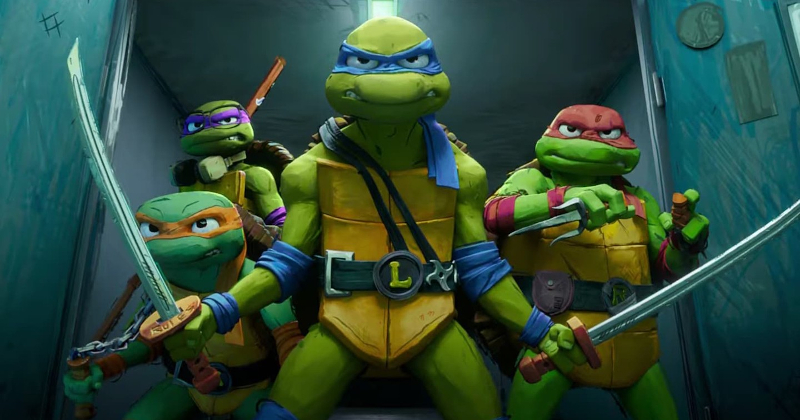Directors – Jeff Rowe, Kyler Spears – 2022 – US – Cert. PG – 99m
*****
The much loved comic-generated franchise gets a remakable reboot in animation that breaks the filmmaking mould to really get under the skin of the teenage experience – out in UK cinemas on Monday, July 31st
Hollywood animated children’s films since the advent of computer animation. They all look the same. Okay, that’s not entirely fair, but with notable exceptions like the Laika films and the recent Spider-Verse films there’s a definite homogeneity to this output overall, industry wisdom dictating the production parameters and the overall look and feel. There’s a mould there, the films make money and producers are terrified to break that mould. Not so here.
The irony is that the Teenage Mutant Ninja Turtles property, born out of a late night joke between two comic book artists who never expected to sell more than a one-off issue, has spawned numerous spin-offs in comics, animated TV series, video games and movies. Somehow, the previous six movies – three in the 1990s (including Teenage Mutant Ninja Turtles, Steve Barron, 1990; Teenage Mutant Ninja Turtles II: The Secret Of The Ooze, Michael Pressman, 1991), one in 2007, and two more in the last decade following a reboot in 2014 – never quite delivered on the promise of the franchise, as if everyone concerned was too focused on the moneymaking potential and trying to play everything safe, an approach completely at odds with that of the two artists who originated the property and simply thought of it as a fun idea worth developing.
This new film is different.
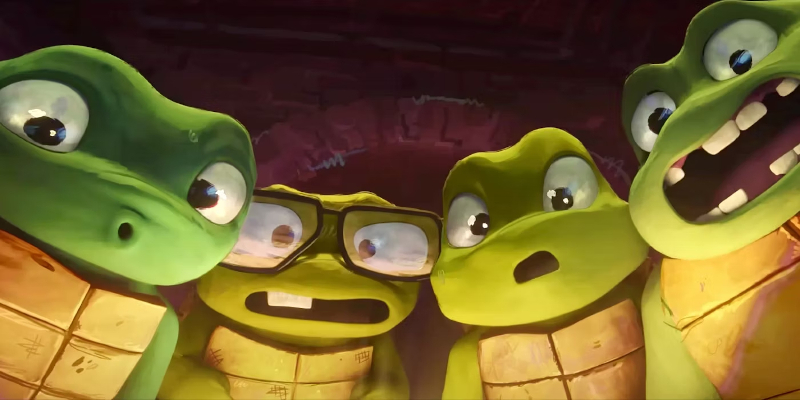
The plot is in part the familiar origin story filmed many times before: fifteen years ago, a phial of green ooze found its way into the sewers of New York to cause the mutation of a number of animals into talking sentient beings, most notably a rat named Splinter (voiced here, in something of a master stroke, by martial arts comedy movie legend Jackie Chan) and the four turtles he takes under his wing. Now teenagers, Leonardo (voice: Nicolas Cantu), Michaelangelo (voice: Shamon Brown, Jr.), Raphael (voice: Brady Noon) and Donatello (voice: Micah Abbey) want to become crime fighters in the world of humans.
However, there’s a problem: the human world is inherently hostile to anything non-human. Having learned this truth the hard way, the turtles’ adoptive father Splinter is a disciplinarian who wants to know where the boys are and what they’re doing whenever they’re out of his sight as he fears for their safety. Being teenagers, though, they are apt to bend and break the rules. And where Splinter has decided that the human world will never accept a mutated animal like him because he is, quite simply, too different, the younger, more optimistic turtles have yet to have their optimism, represented by their belief that they can somehow fit in to human society and carve out within in a niche for themselves, crushed.
(You might even argue that the idea that the human world is inherently hostile to anything non-human is a pretty effective metaphor for the way teenagers often feel about adult human society.)
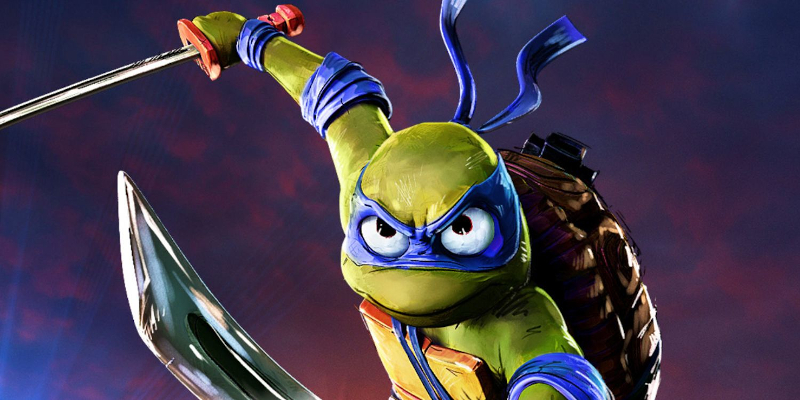
Simply put, these mutant animals crave human acceptance. And that motivation extends to the many other mutants in the narrative here, among them archvillain Superfly (voice: Ice Cube) who keeps his identity secret by killing anyone outside of his criminal fraternity who sees him. Superfly was created by Baxter Stockman (voice: Giancarlo Esposito), the same scientist whose green ooze found its way into the sewers. Here, that happened when his lab was raided by corporate executive Cynthia Utrom (Maya Rudolph) of the Techno Cosmic Research Institute (TCRI).
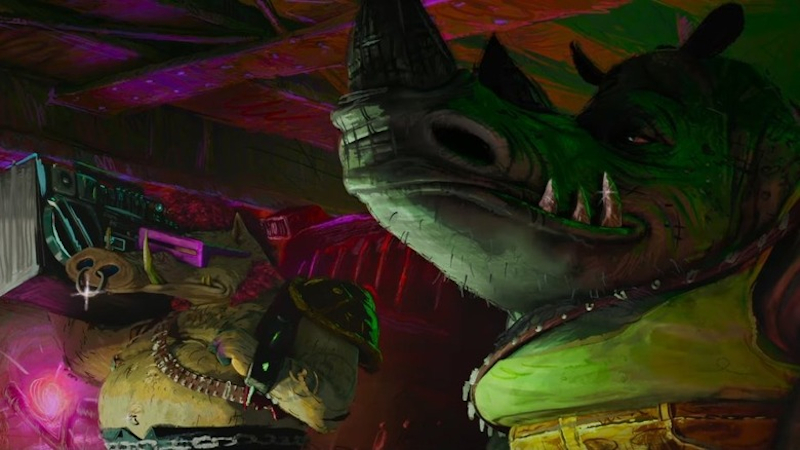
Also featured in comparatively minor roles are a plethora of other mutants comprising that fraternity who will be familiar to fans of the franchise: Bebop (voice: Seth Rogen), Rocksteady (voice: John Cena), Mondo Gecko (voice: Paul Rudd), Wingnut (voice: Natasia Demetriou), Genghis Frog (voice: Hannibal Buress) and Ray Fillet (voice: Post Malone).
The four turtles find acceptance in fellow teenager April O’Neil (voice: Ayo Edebiri), an aspiring journalist who edits her high school paper after screwing up an attempt to become school TV channel anchorwoman when nerves caused her to throw up on camera, earning her the nickname Puke Girl.
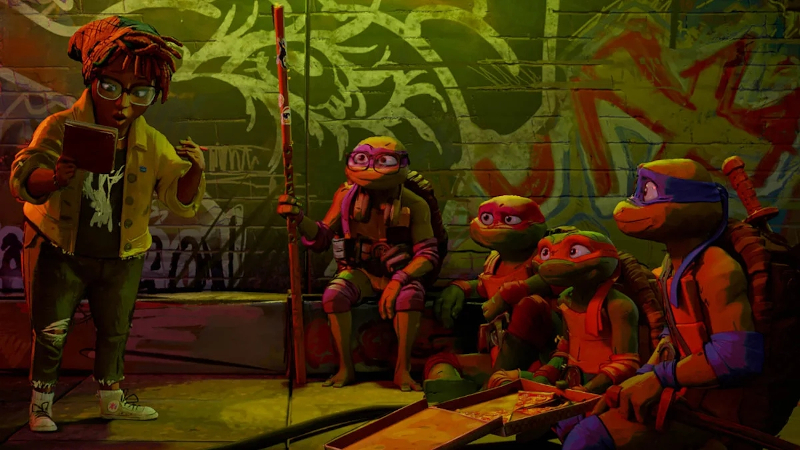
This new movie adaptation of the franchise represents the first time that the four teenage turtles have been played by teenagers. This seems an obvious decision given the franchise’s title, but incredibly it’s not been done before. Apparently that is down to Seth Rogen, one of the producers here who has a knack for exploring teenage life on screen. For that matter, it’s also the first time journalist April O’Neil has been portrayed as a teenager, a decision likely to endear the film to female fans as well as the obvious teenage male target audience.
For director, Rogen picked Jeff Rowe (co-director of The Mitchells Vs. The Machines, 2021), who with Rogen’s support pushed the teenage emphasis still further when he recorded the four teenagers voice acting the turtles not singly, as would traditionally be done, but together so that they frequently overlap dialogue and riff off each other, sounding much more like teenagers fooling around than they would if recorded separately.

However, Rowe’s vision pushed the teenage idea a lot further than that, though: he wanted the animation to look like teenager’s drawings, with lots of scribbling and ‘incorrect’, ‘undisciplined’ or just plain ‘wrong’ aesthetics. You need look no further than most new movements in the history of art to see that throwing out rules and challenging what went before is generally a vital element in their formation; while no-one is suggesting the new Teenage Mutant Ninja Turtles movie is quite as culturally significant as a new art movement, much like the Spider-Verse movies it breaks the mould and pushes the boundaries of both movies and animation media.
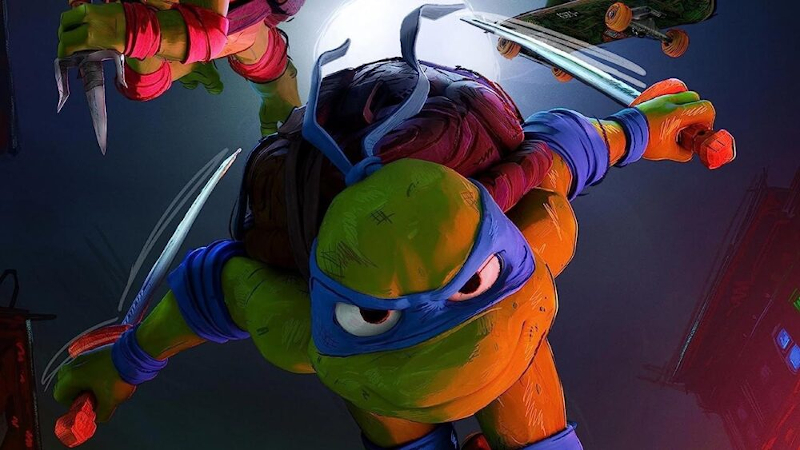
More impressive yet, Mutant Mayhem gets where it wants to go by brave forms of creative innovation which don’t necessarily cost an arm and a leg. As eye candy, it’s exhausting (I mean that as a compliment, because, again like the Spider-Verse films, it could repay multiple viewings with considerable visual rewards for the viewer – however, be advised that the still images don’t even begin to do justice to the incredible visuals). The word that constantly springs to mind here is ‘painterly’. Such painstaking care has been lavished on individual batches of animated frames that there’s a real pleasure to be had here watching, for example, the surfaces of the turtle characters as they seem to change in real time like the surface of an animated oil painting (a viewing experience not entirely unrelated to watching the thumbprints moving around on the surface of stop-frame characters animated in a material such as plasticine). This aesthetic serves to give the film a strongly teenage feel. It isn’t just that the five main character roles are voice-acted by teenagers, but rather that the form of the film itself explores something of the teenage experience.
That makes it one of the best animated films both about and aimed at teenagers to come out of Hollywood in recent years. Which is an altogether remarkable achievement.
Teenage Mutant Ninja Turtles: Mutant Mayhem is out in cinemas in the UK on Monday, July 31st.
Teaser trailer:
Trailer:
